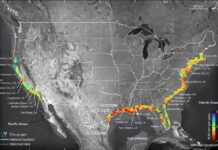By Dan Purizhansky
In late January and early February, news headlines across the world were dominated by news of a “polar vortex” in North America. Millions of students were forced to stay at home while thousands of schools and other institutions were closed during record cold temperatures and huge amounts of snow. According to National Geographic, at least 21 people had died in conditions which could cause frostbite in a matter of minutes.
This weather phenomenon occurred as a large mass of frigid air escaped from the Arctic Ocean and moved south to the Midwest and the Northeast regions of the United States. This mass of air had previously been part of a vortex that had rotated counterclockwise around the North Pole. As a jet stream wind picked up the southern edge of the vortex, the polar jet stream was formed. Because jet stream winds move from west to east, the northeastern part of North America got hit the hardest by this cold air body. Strong jet stream winds cause pockets of extremely low temperature Arctic air to get trapped. Therefore, as the polar jet stream moved south, cities like Chicago experienced record low temperatures that were colder than those in Antarctica.
Many scientists believe that the polar vortex may be an indicator of climate change. Some claim that climate change caused the polar vortex to lie lower and further south than usual. Because jet stream winds are partially fueled by temperature differences, Although many believe that climate change could cause more unstable polar vertices, more research is required to ultimately prove this connection.









